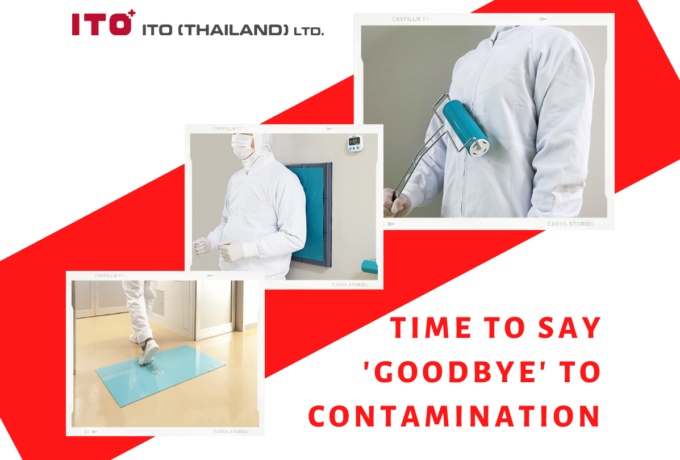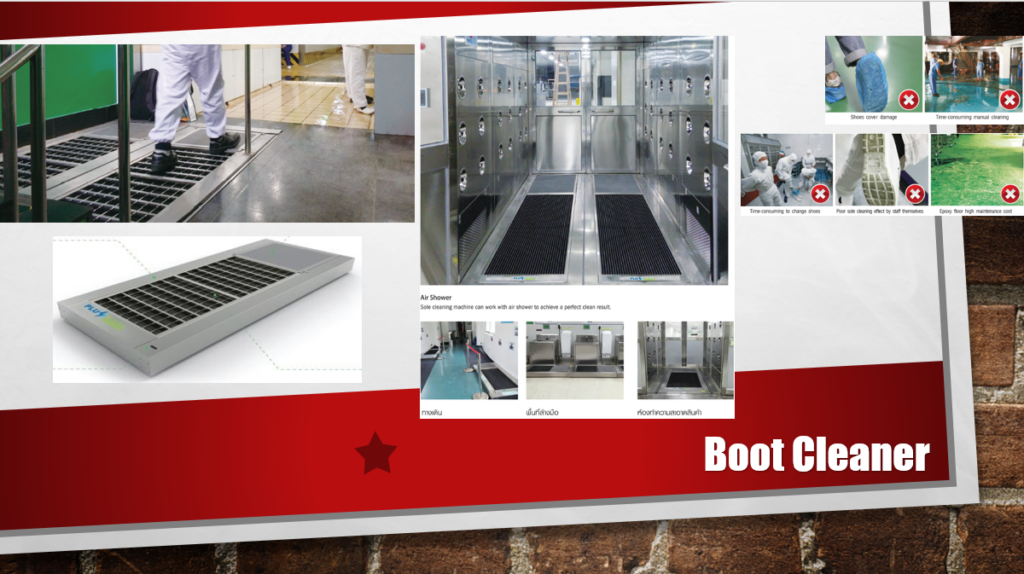ITO Thailand Hygiene Blog
Boot Cleaner
4 risks that footwear brings into your factory
• Because of gravity
Everything on this planet is pulled by the gravity towards the earth. Consequently, footwear, which is the largest points of contact with the ground, has the greatest risk of contamination. The contamination can be external – soil, dust, insect remains, animal feces, sewage, or it can be during the work process that is likely to come into contact with undesirable substances in the work area such as manure from the barn, animal blood and fat from meat slaughter, food waste from peeling, cutting, preparing raw materials, chemicals from manufacturing or cleaning, allergens from proteins in raw materials, etc., all of which may pose a risk of physical, chemical, and microbial harm to food as well as and allergens in food.
• Nooks and crannies for germs
Not only is footwear most exposed to dirt, but it may also collect microorganisms with its nooks and crannies that are necessary to support the workers’ feet. These microorganisms can also come from the environment, the workers’ own feet, as well as their skin or sweat which is food of the microorganisms. Some of these microorganisms may be pathogens or expedite food decay, and they can be contaminants. Therefore, footwear should be made from suitable materials that are easy to wash, clean and disinfect. (1)
• Cross-contamination
As mentioned, footwear is exposed to risk of contamination that is not only from the outside, but the contamination can also occur between rooms or zones in the factory. Particularly, if the footwear accumulates a large amount of dirt, disinfection may not destroy the microorganisms entirely because it is obstructed by the dirt (see more on cleaning and disinfection). Contaminated footwear can be a carrier of contaminants and spread them to a great distance. There has been research (2,3) that studies that on wet floors, the footwear can carry the contaminants for as far as 47 meters.
• Safety and welfare of the workers
In addition to product safety, the footwear has significant impact on the safety and welfare of the workers. Therefore, the footwear must be designed properly, with anti-slip soles to prevent accidents. Their quality must be sufficient to protect the workers from the work environment (temperature, chemicals, heavy or sharp objects) and suitable to support the weight of the workers, especially in a system where the workers have to stand for long hours.(1)
3 tips to manage footwear in your food factory
• Control footwear from the outside
Notification of the Ministry of Public Health (No. 420) (4) stipulates that worker must wear clean footwear during work. In practice, the best control for clean footwear is to change into footwear used in the building only. The footwear may depend on the type of work – boots for wet areas, shoes for dry areas (5), and made from appropriate materials that are easy to clean and disinfect. For visitors, they may use temporary shoe wrappers, subject to appropriateness. Moreover, additional measures may be put in place such as stepping on dust-trapping mats to reduce dust stuck on the shoe treads in the building.
• Separate site footwear by risk level
Other than changing footwear when entering the building, footwear control between areas with different risk levels is also necessary as the footwear can be a carrier of cross-contamination. According to hygiene standards in the food industry such as BRC Standard(6) , item 8.4.1, footwear must be changed when entering a high risk or high care area. Site footwear must not be worn outside of the area, and proper control must be in place to ensure that there is no contamination of pathogens to the production area with such risk.
• Cleaning and disinfection
Footwear used in the production process must always be clean. It must be cleaned and disinfected simultaneously to prevent pathogen contamination. The cleaning process consists of brushing using a cleaning brush and cleaning solution (depending on the filthiness and type of work) and disinfection by spraying disinfectant solution or walking in a chlorine pit. The workers must pay attention to cleaning. If cleaning is done improperly, the pathogens may not be removed. In a study(7) , it was found that after a test to see pathogens on footwear used in a seafood factory after cleaning, the contamination of Listeria monocytogenes was still as high as 10.5%. One of the footwears tested belonged to a quality control employee who had to walk in and out of rooms to control the quality of products. Therefore, if footwear is contaminated, it is highly likely that the contamination will spread to other parts of the factory.
Nowadays there is a technology that cleans footwear with an automatic shoe cleaner. The device comprises a sensor that detects workers, a cleaning brush that rotates automatically to brush the top and/or bottom of the footwear (depending on its type). This enables better quality control for cleaning than having the workers do it themselves. It is easy and safe to use. Input of the cleaning or disinfectant solution can also be chosen and adjusted according to your needs. If you are interested in the product, you can contact us to talk and make an appointment to test the product immediately.
References
1.Margas, E., & Holah, J. T. (2014). Personal hygiene in the food industry. In Hygiene in Food Processing(pp. 408-440). Woodhead Publishing.
2.TAYLOR , J. H. , HOLAH , J. T. , WALKER , H. and KAUR , M. (2000 ), Hand and footwear hygiene: An investigation to defi ne best practice . R & D Report No. 112, Campden BRI.
3.Todd, E. C., Michaels, B. S., Greig, J. D., Smith, D., Holah, J., & Bartleson, C. A. (2010). Outbreaks where food workers have been implicated in the spread of foodborne disease. Part 7. Barriers to reduce contamination of food by workers. Journal of food protection, 73(8), 1552-1565.
4.Notification of the Ministry of Public Health (Number 420) of B.E. 2563 Issued by the Virtue of the Food Act of B.E. 2522 Title: Food Production Processes, Processing Equipment/ Utensils and Storage Practices
5.https://www.fda.moph.go.th/sites/food/Shared%20Documents/GMP/GMPKM_20.pdf
6.BRC Global standards. 2018. Global Standard Food Safety issue 8
7.Gudbjörnsdottir, B., Suihko, M. L., Gustavsson, P., Thorkelsson, G., Salo, S., Sjöberg, A. M., … & Bredholt, S. (2004). The incidence of Listeria monocytogenes in meat, poultry and seafood plants in the Nordic countries. Food Microbiology, 21(2), 217-225.
Related Post
-

Liquid nitrogen in food industry
You maybe have heard that liquid nitrogen can rapidly freeze the food, haven’t you? And what are its advantages and benefits? Let's get to know the liquid nitrogen in food industry with ITO (Thailand).
-

Ultrafine bubble (UFB) technology (Part 2)
The previous content has discussed the benefits of the ultrafine bubble technology in agriculture, livestock, and fisheries, cleaning raw materials and various surfaces. Today, we will continue to learn about the use of the ultrafine bubble technology in food production processes and waste management from the food industry and how to create these tiny gas bubbles.
-

Ultrafine bubble (UFB) technology (Part 1)
Simple bubbles when transformed into the micro-nano level can do more than you think. Let's learn about the technology of these tiny bubbles and their application in the food industry with ITO (Thailand).
-

Frozen food storage management
Freezing is a method of food preservation commonly used in food that goes bad quickly such as ready-to-cook fresh food, ready meals, or foods in which nutritional values decay easily, or have substances that are sensitive to temperature, light, oxygen, etc. Freezing uses a principle of quickly solidifying water in the products, making the molecules of the substances unable to react to one another, thus the foods last longer. It also suppresses the growth of microorganisms and kills parasites. For instance, USFDA suggested controlling parasites in fish consumed raw such as sushi and sashimi by freezing the fish at the minimum of 20 degrees Celsius for 7 days or stored at -35 degrees Celsius for 15 hours to control parasites in fish (conditions may depend on the size of the fish as well).
-

Innovation for sustainable physical contamination prevention
It is known that external impurities pose a food safety risk. One of the main channels of contamination is the presence of humans as a carrier of dust and dirt into the production or high-risk areas, causing dirt, germs, or foreign matters to contaminate food and harm consumers.
-

AI technology in Food industry world
Case study of HACCP assisted hand washing system by AI technology











